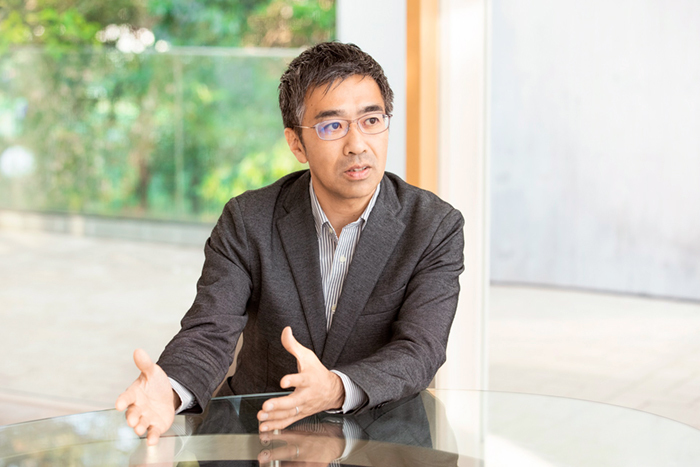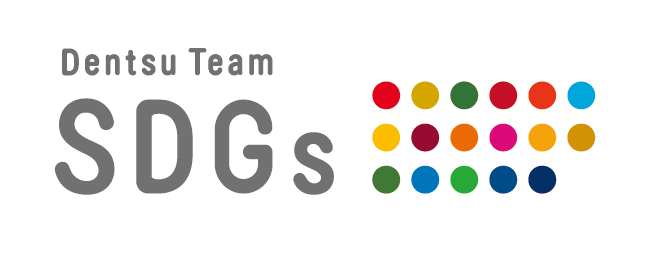What are the expanding possibilities for SDGs through "Business × University"?
Professor Norifumi Kanie is recognized as a leading authority in SDGs research. Centered around Keio University's "xSDG Lab," he spearheads various initiatives where companies, local governments, and universities collaborate to advance the SDGs.
What kind of synergy for the SDGs emerges from partnering with students and researchers? While also addressing societal challenges shifting due to the impact of the novel coronavirus, he spoke on the theme of "Corporate × University SDGs."

Working with financial institutions and certification bodies to organize SDG-related frameworks
──Professor Kanie, you lead the "xSDG Lab" at Keio University's Shonan Fujisawa Campus. What kind of activities does it undertake?
Kanie: The "xSDG Lab" is a research organization dedicated to creating and accumulating best practices related to the SDGs. It aims to achieve truly sustainable growth by "crossing over" (xSDG) the SDGs with various societal activities and technologies—such as initiatives by companies and local governments, consumption and investment activities, and IoT.
Within the lab, there is a research consortium (joint venture) that collaborates with companies and local governments on SDGs, undertaking various initiatives.
──What specific initiatives are you working on?
Kanie: Last fiscal year, we tackled three key issues: "Corporate Evaluation Review," "Certification System Reorganization," and "Plastic Issues."
Regarding "Corporate Evaluation," we primarily worked with financial institutions. Many financial institutions are now focusing on "impact investing"—investing in companies engaged in social enterprises and similar ventures.
However, the substance of how to evaluate companies for impact investing and other social investment activities—the criteria and metrics—is largely undisclosed.
Even when disclosed, the connection to the SDGs is often weak and difficult to understand. Therefore, together with several financial institutions, we worked to establish criteria that can be considered the "correct" SDGs actions for corporate evaluation and assessment in the financial sector.
"Organizing certification systems" refers to our efforts to clarify the relationship between certification systems like FSC (Forest Stewardship Council) and MSC (Marine Stewardship Council) and the SDGs.
We gathered organizations handling certifications highly compatible with the SDGs and companies interested in certification systems to investigate and discuss questions like, "By obtaining this certification, what SDG goals can be contributed to?"
Take FSC, for example. While it has a direct and strong link to SDG 15, "Life on Land," it is also deeply connected to various other SDGs, including poverty, hunger, clean energy, labor conditions, and climate change. We organized these connections, compiled a list of "Goals FSC Can Contribute to Achieving" and their "Achievement Targets," and took it to the point of publication.
Additionally, the subcommittee addressing "plastic issues" compiled and will present a proposal titled "A Roadmap for Realizing Japan's Plastic Utilization Approach from an SDG Perspective."
The defining feature of the xSDG Lab Consortium is that these initiatives are undertaken collaboratively by approximately 20 companies, three local governments, the national government, and universities. The consortium holds three general meetings and one symposium annually. Additionally, subcommittees meet frequently to tackle challenges head-on.
Students with fresh perspectives are energizing the discussion on SDGs!
──How are students involved in the activities of the "xSDG Lab"?
Kanie: They assist with various activities while learning about the SDGs. They participate in different surveys and sometimes engage in discussions with corporate representatives. They help in many ways.
──Are they all highly interested in SDGs from the start? What mindset do you feel they bring to the lab's activities?
Kanie: I think many students join simply because it "seems kind of interesting." However, even though it's "kind of," I sense an underlying awareness that "doing good things is just the right thing to do."
Today's students experienced the Great East Japan Earthquake around age 10. Witnessing nature's power during their formative years made them realize that everyday life isn't guaranteed. Perhaps that's why they naturally developed a desire to do what's good for the planet and people. I get the impression their values differ somewhat from our generation's.
──Many experts involved with the SDGs say, "Young people have a stronger sense of social contribution and altruism than Showa-generation adults realize." Businesspeople who feel they must tackle the SDGs, and young people who want to do "good things" without even consciously thinking about the term "SDGs." What kind of synergy do you think could emerge when these two groups collaborate?
Kanie: When companies operating within economic frameworks collaborate with young students who have a pure perspective, something... the essence seems to emerge. I feel this is creating innovations that companies or local governments alone couldn't achieve.
SDGs often proceed by first setting goals and then figuring out "how to achieve them." For these backcasting-style projects, students—unburdened by extra constraints and prior knowledge—can approach them with a pure perspective. They offer ideas and insights from a fresh viewpoint: "Why are we doing something so wasteful?" or "Why aren't we doing this if we can?"
Take our joint research with Ryohin Keikaku, the company behind Muji. While Ryohin Keikaku is inherently highly sensitive to sustainability, having universities and students join discussions and investigations revealed things like, "Hmm, there might still be more we can do," or "Surprisingly, there might be quite a few things we aren't doing yet."
Observations like, "While products like organic cotton T-shirts are advanced and positive from an SDGs perspective, the manufacturing process uses non-renewable energy sources like petroleum and coal," or "There's still room for improvement, like switching from non-renewable to renewable energy." Even just from the Muji case, we made many discoveries, which I found incredibly interesting.
Companies are organizations that must continuously generate profits, large or small. Therefore, they must engage with the SDGs while balancing "economic activity" and "social contribution" – two things that are logically difficult to reconcile. That's precisely why I believe the presence of today's students, who hold a perspective leaning towards social contribution, can be immensely helpful.
As the world changes due to COVID-19, I want to rethink sustainable societies.
—Could you share any tips for how companies can connect with students?
Kanie: I think it's best to approach them with the mindset of "seeking perspectives we lack" and "engaging in dialogue." Students may lack knowledge or experience in many areas. However, adopting an attitude like "You don't even know this?" or "You should have studied more" defeats the purpose. I really hope companies will listen to the students' opinions.
Another crucial point is for companies to be upfront about their true intentions. Occasionally, we see cases where companies say, "We're tackling SDGs as part of our recruiting efforts to spark student interest." If that's the case, I wish they'd state it clearly from the start. Rather than hiding it awkwardly, clearly stating the purpose will help the project progress more smoothly.
In the past, collaboration between companies and researchers was quite difficult. They used different languages and engaged in different activities. Communication often broke down, connections failed to form, and many projects stalled as a result.
However, with the advent of the SDGs, we now have a common language for action. Industry-academia collaboration should expand even further from here. I expect this will lead to innovations and bold transformations where both sides gain something.
──I'm looking forward to seeing how this expands. On the other hand, what do you see as the challenges? What should companies be mindful of when promoting the SDGs?
Kanie: The challenge I see is that companies often focus only on what suits them. They link SDG goals to their business and end up just promoting "look at our great initiatives," without seeing the broader context of other social issues behind them.
For example, a company might decide to launch a new power generation project to achieve Goal 7 ("Affordable and Clean Energy"), but then fail to establish a plan for handling the industrial waste generated by that project. Or, a large corporation might operate entirely on its own, failing to create connections that enrich local industries and people, ultimately not contributing to sustainable community development... I believe we must ensure consistency even when viewed from perspectives beyond the specific SDG goals we champion. Increasing the number of SDGs that demonstrate consistency when examined from multiple angles will be essential going forward.
Furthermore, I believe it's crucial that the transformation unexpectedly brought about by the novel coronavirus pandemic does not become temporary. If we steer wrongly when the pandemic subsides and the economy recovers, I fear we will once again start walking down the path of mass production and mass consumption, spewing CO2.
Therefore, we must not return to the past. The global pandemic, the contraction of economic activity, the resulting layoffs, and the issues surrounding work styles that have emerged over the past few months are also evidence that we have not yet achieved a sustainable society. I believe we must move to improve and solidify these changes.
I believe countermeasures against the novel coronavirus are inherently aligned with advancing the SDGs. More comprehensively, more sustainably. It is crucial to establish this transformation with strong resolve.

TeamSDGs collaborates with various SDG stakeholders to disseminate information about the SDGs and plan/develop solutions.
※Please also see Professor Kaniue's article here
Student × Corporate SDG Projects Fostering Learning and Growth: Keio University "xSDG Lab" Representative Professor Norifumi Kanie
Was this article helpful?